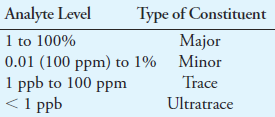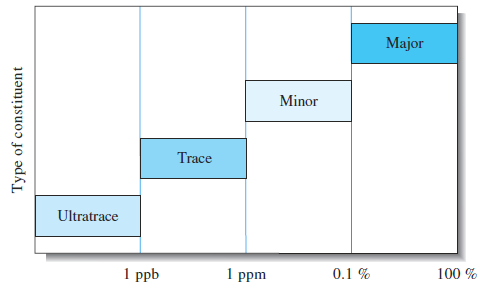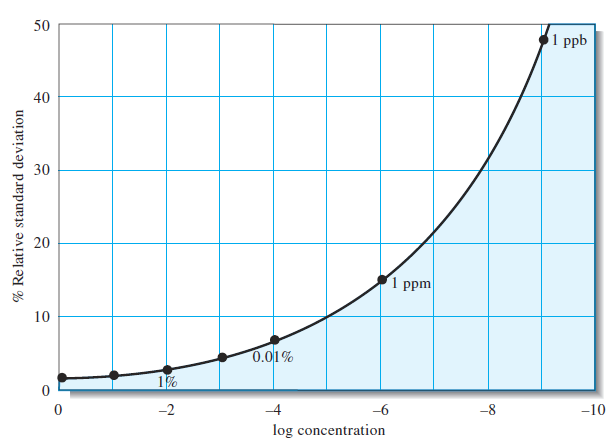
Constituent Types
 المؤلف:
D. A. Skoog, F. J.Holler, D M. West, and S. R. Crouch
المؤلف:
D. A. Skoog, F. J.Holler, D M. West, and S. R. Crouch
 المصدر:
Fundamentals of Analytical Chemistry
المصدر:
Fundamentals of Analytical Chemistry
 الجزء والصفحة:
9th. p 154
الجزء والصفحة:
9th. p 154
 7-5-2017
7-5-2017
 3177
3177
Constituent Types
The constituents determined in an analytical procedure can cover a huge range in concentration. In some cases, analytical methods are used to determine major constituents, which are those present in the range of 1 to 100% by mass. Many of the gravimetric and some of the volumetric procedures discussed in Part III are examples of major constituent determinations.

As shown in Figure 1.1, species present in the range of 0.01 to 1% are usually termed minor constituents, while those present in amounts between 100 ppm (0.01%) and 1 ppb are called trace constituents. Components present in amounts lower than 1 ppb are usually considered to be ultratrace constituents.

Figure 1.1 Classification of constituent types by analyte level.
Determining Hg in the ppb to ppm range in a 1-mL (<1 mg) sample of river water would be a micro analysis of a trace constituent. Determinations of trace and ultratrace constituents are particularly demanding because of potential interferences and contaminations. In extreme cases, determinations must be performed in special rooms that are kept meticulously clean, free from dust and other contaminants.
A general problem in trace procedures is that the reliability of results usually decreases dramatically with a decrease in analyte level. Figure 1.2 shows how the relative standard deviation between laboratories increases as the level of analyte decreases. At the ultratrace level of 1 ppb, interlaboratory error (%RSD) is nearly 50%. At lower levels, the error approaches 100%.

Figure 1.2 Interlaboratory error as a function of analyte concentration. Note that the relative standard deviation dramatically increases as the analyte concentration decreases. In the ultratrace range, the relative standard deviation approaches 100%.
 الاكثر قراءة في مواضيع عامة في الكيمياء التحليلية
الاكثر قراءة في مواضيع عامة في الكيمياء التحليلية
 اخر الاخبار
اخر الاخبار
اخبار العتبة العباسية المقدسة


